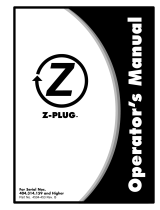
1017056-A
3
GENERAL NOTES (OPERATION)
Caution should be taken when using any attachment. This
attachment combined with the weight distribution, turning
radius, and speed of vehicle can result in severe injury or death
to operator, damage to vehicle, and/or attachment if not used
properly. Follow all safety precautions noted in the vehicle
owner’s manual, including the following precautions:
• Do not exceed maximum capacity of attachment.
• Only use this product in the vehicle’s tow mode/speed
setting or less than 5 mph. Do not exceed 5 mph.
• Operating speed should always be slow enough to
maintain control. Travel slowly, using caution when
traveling over rough terrain. Avoid holes, rocks and roots.
• Slow down before you turn and do not turn sharply.
• Use caution when turning. Vehicle has greater tail swing
with attachments.
• Use caution when operating around retaining walls and
other raised embankments.
• Do not use attachment on steep slopes. A heavy
load could cause loss of control or overturn attachment and
vehicle. Additional weights need to be added to your vehicle.
• Reduce weight when operating on slopes.
• Keep all movement on slopes slow and gradual. Do
not make sudden changes in speed, directions or turning.
• If you start and stop suddenly on hills, you may lose
steering control or the vehicle may tip.
• Do not start or stop suddenly when going uphill or
downhill. Avoid uphill starts.
• Slow down and use extra care on hillsides. Turf conditions
can affect vehicle stability. Use extreme caution while
operating near drop-offs.
• Do not drive close to creeks, ditches and public highways.
• Watch out for trafc when crossing roadways.
• Use care when loading or unloading the vehicle into a trailer
or truck.
• The attachment can obstruct the view to the rear. Use extra
care when operating in reverse.
• When reversing, back up straight using caution.
• Stop on level ground, disengage drives, set the parking
brake, and shut off engine before leaving the operator’s
position for any reason including emptying the attachment.
• Use this attachment for intended purpose only.
• This attachment is intended for use in lawn care and home
applications. Do not use at speeds higher than maximum
recommended speed.
• Always wear substantial slip-resistant footwear. Do not wear
loose-tting clothing, tie back long hair and do not wear jewelry.
• Keep your eyes and mind on your vehicle, attachment and
area being covered. Do not let other interests distract you.
• Stay alert for holes and other hidden hazards in the terrain.
• Keep the vehicle and attachment in good operating
condition and keep safety devices in place.
• The vehicle and attachment should be stopped and
inspected for damage after striking a foreign object. Any
damage should be repaired before restarting and operating
the equipment.
• Keep all parts in good condition and properly installed. Fix
damaged parts immediately. Replace worn or broken parts.
• Replace all worn or damaged safety and instruction decals.
Keep all nuts, bolts and screws tight.
• Do not modify the attachment or safety devices.
Unauthorized modications to the vehicle or attachment may
impair its function, safety and void the warranty.
VEHICLE AND ITS SAFETY
• Know your vehicle controls and how to stop safely. READ
YOUR VEHICLE OWNER’S MANUAL before operating.
• Check the vehicle’s brake action before you operate. Adjust
or service brakes as necessary.
• Stopping distance increases with speed and weight of load.
Travel slowly and allow extra time and distance to stop.
• Use only approved mount (Toro model no. 131-3966). Do not
connect this attachment except at the approved mount point.
• Do not operate without counterweights (Toro model no. 131-
7658).
• Do not shift to neutral and coast downhill.
• Do not allow adults to operate the vehicle without proper
instruction or without having read the owner’s manual.
• Do not allow children to operate the vehicle.
PROTECT THOSE AROUND YOU
• Before you operate any feature of this attachment or vehicle,
observe your surroundings and look for bystanders.
• Keep children, bystanders and pets at a safe distance away
while operating this or any attachment.
• Use care when reversing. Before you back up, look carefully
behind for bystanders.
KEEP RIDERS OFF ATTACHMENT AND VEHICLE
• Do not carry passengers.
• Do not let anyone, especially children, ride in/on this
attachment, the vehicle or mount bracket.
• Riders are subject to injury such as being struck by foreign
object and/or being thrown off during sudden starts, stops
and turns.
• Riders may also obstruct the operator’s view resulting in this
attachment being operated in an unsafe manner.
SAFETY
================================================================================================





















